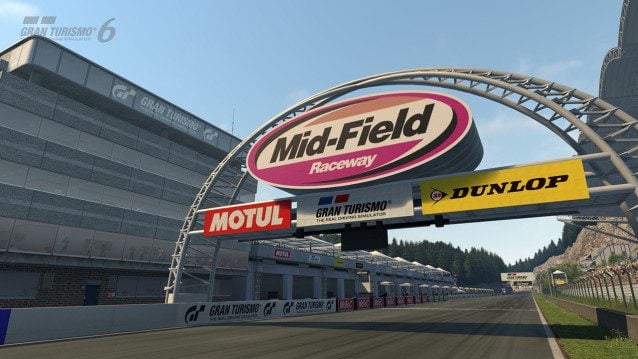
There’s been a ton of really good fictional tracks throughout the racing genre. Often memories of our favorite circuits are intertwined with our favorite games too. There’s no way this is simply a coincidence.
In the current generation, we’re so obsessed with realism that sometimes we forget about the Fujimi Kaidos of the racing world in favor of yet another version of the Green Hell to tackle. For the racing genre, we feel it’s key the importance of these fictional tracks is not forgotten as racing titles get more complex in their never-ending chase for realism.
There’s something special about the allure of original racing tracks in driving games. Thinking back throughout the years, we always remember moments like the first endurance race on Seattle Circuit in Gran Turismo 3, and taking on Lakeside for the first time in SEGA Rally Championship 1995. Getting the chance to drive this hidden circuit as a prize for finishing 1st overall is a memory that feels just as vivid all these years later. If it were an existing real world track we don’t think it would have had such an impact.

The finest example of a series which has made its mark through fictional circuits as much as replicas is obviously Gran Turismo. If you were asked to name a series with more memorable fantasy tracks you’d struggle, even if we’re including totally fictional track rosters like Driveclub.
It isn’t a surprise that Gran Turismo’s plethora of fantasy circuits make it stand out compared to its fellow racing game series. In an era of laser-scanning and photography-based track capture, there’s simply something in an original track that can’t be delivered from a real-life representation: suspension of disbelief.
It’s clear Gran Turismo’s legacy still lives on in part thanks to its great original entries in the track roster. When it comes to fantasy circuits, it’s almost unanimous that GT has always had the Midas touch at creating circuits unique to the franchise. At first glance it may not seem that big of a deal, but we’d wager a large part of GT’s success comes from tapping into feelings of nostalgia.
You’ll rarely hear casual racing fans talk about taking on the Karussell at the Nordschleife, but remind someone about that one head-to-head at Tahiti Maze in GT3 and they’ll remember it like it was yesterday, recalling every last detail.
https://youtu.be/Ird5VIG3mUY
Seattle is a great case when pointing out how iconic original circuits can be. The latter-half of the circuit is the best part, where we speed down a steep decline, greeted by the perfect pink and blue sky setting on the stadium section. To help recreate this feeling, we’ve put together a lap of Seattle Circuit from GT4 to refresh your memory. The circuit is truly one of the GT greats.
We know moving forward that the Gran Turismo series will continue to feature original tracks such as Fisherman’s Ranch, Tokyo Expressway and the new Dragon Trail Raceway. We hope PD continues to invest time and effort into making its newest selection of tracks as memorable as those before it, creating memories and good times in the process.
The truth is that every racing game can attempt to include a list of great real-world racing tracks, but to truly stand out from the pack content unique to the franchise is important. Thankfully, this notion doesn’t appear to be lost on modern developers. Kunos Simulazioni has already released Black Cat County and the Scottish Highlands track to Assetto Corsa — both original creations based off authentic locations.
The two Kunos-designed fantasy tracks focus on a particular aspect too often ignored in realistic racing games: the feeling of driving on an open road.

Looking at Forza, Turn 10 has always seen the value in fictional tracks with Fujimi Kaido, Bernese Alps, and Rio being particular standouts — the latter was the highlight track to show off the game when you first booted up Forza Motorsport 6. The best way to make a good first impression is to showcase these tracks that only that series can offer; it makes it even better if the tracks themselves are great fun to drive too.
Fujimi Kaido is undeniably the fan-favorite when it comes to Forza Motorsport’s offerings however, though the sprawling Japanese mountain climb hasn’t been seen since appearing in Forza Motorsport 4. With the impressive car roster of the recent games, we can only wonder how beautiful the track would look with Xbox One and Scorpio level visuals. Simply put, it would be a photographer’s dream. The return of the track would give the game an edge over its competitors too — there’s nothing quite like Fujimi Kaido.

Slightly Mad Studios actually has a knack for original circuits itself. Looking at the EA-published Need for Speed: Shift, the London track was at the forefront of the reveal materials when the game was first announced. For the time, it looked fantastic thanks to good use of instantly recognizable areas of the English capital city. Big Ben, London Eye, Westminster Bridge and even the BFI iMAX cinema are represented throughout the fast circuit.
It was a good example of using a real-life locale to create a possible racing track around one of the big capital cities of the world. Coincidentally, a London circuit was put together for FIA’s Formula E series years later but truth be told – SMS’s effort looks a lot more fun to drive. Fast forward to the present day and Project CARS continues the legacy set up from the Shift series.
A stand-out in the series is the beautiful Azure Coast; a point-to-point race through the heart of Monaco. Many titles have their own unofficial version of the Monaco grand prix circuit due to licensing – in fact Project CARS had its own too, but Slightly Mad Studios went a step further in creating this stunning track.

When developers go to the effort of making these fictional circuits, they must ensure that they are worthwhile and not a simple bump in the overall track count. We don’t need a lot of unofficial variants for existing race circuits – “that slightly off version of Suzuka” isn’t going to be as memorable as a unique circuit built from the ground up. This alone gives these circuits a level of importance level with (or even above) their real-life counterparts.
Gran Turismo Sport, Forza Motorsport 7, Project CARS 2, Assetto Corsa and other upcoming realistic racers — they should all continue to aim for fantasy track inclusion, and never underestimate the long-lasting positive memories they can bring to the audience.
Here’s to the imaginative minds in the racing genre and the tracks that come to life as a result of them. Please don’t forget about original circuits: they offer a totally different experience to the real tracks around them, and offer racing venues unique to their respective franchise that could only exist because of the team’s creativity.










